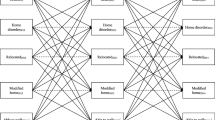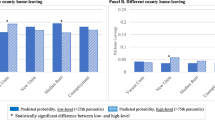Abstract
This paper identifies factors which differentiate elderly residential movers and non-movers. Longitudinal data were used in the analysis. Logistic regression results showed that length of residency, home ownership, use of community support services, and number of adult children each had an effect on relocation. Respondents who reported longer lengths of residency and those who owned a home were less likely to relocate. Those elders who utilized more community support services were also less likely to move. Conversely, elders with greater numbers of adult children were more likely to relocate. There was not a significant effect of health status on relocation.
Similar content being viewed by others
Reference
Barsby, S. L. and Cox, D. R. (1975). Interstate migration of the elderly. Toronto: Heath-Lexington.
Bengtson, V. L., Olander, E. B. and Haddad, A. A. (1976). The generation gap and aging family members: Toward a conceptual model, in: J. Gubrium (ed.), Time, roles, and self in old age. New York: Human Sciences Press.
Brody, E. M. (1985). Parent care as a normative family stress, The Gerontologist 25: 19–29.
Bryant, E. S. and El-Attar, M. (1984). Migration and redistribution of the elderly: A challenge to community services, The Gerontologist 24: 634–640.
Cantor, M. H. (1983). Strain among caregivers, The Gerontologist 23: 597–604.
Colsher, P. L. and Wallace, R. B. (1990). Health and social antecedents of relocation in rural elderly persons, Journal of Gerontology 45: 32–38.
Ferraro, K. F. (1982). The health consequences of relocation among the aged in the community, Journal of Gerontology 38: 90–96.
Horowitz, A. (1985). Sons and daughters as caregivers to older parents: Differences in role performance and consequences, The Gerontologist 25: 612–617.
Johnson, C. L. (1983). Dyadic family relations and social support, The Gerontologist 23: 377–383.
Kaufman, R. L. (1990). Fortran Program for Calculating Standardized and Semi-Standardized Coefficients for Logistic Regression. Ohio State University, Department of Sociology.
Kaufman, R. L. (1992). Comparing effects in dichotomous logistic regression: A variety of standardized coefficients. Paper presented at the 1992 Annual Meetings of the American Sociological Association, Session on Quantitative Methodology.
Lawton, M. P. (1986). Environment and Aging. Albany: Center for the Study of Aging.
Leslie, G. R. and Richardson, A. H. (1961). Life cycle, career pattern, and the decision to move, American Sociological Review 39: 894–902.
Litwak, E. and Longino Jr., C. F. (1987). Migration patterns among the elderly: A developmental perspective, The Gerontologist 27: 266–274.
Longino Jr., C. F., Jackson, D. J., Zimmerman, R. S. and Bradsher, J. E. (1991). The second move: Health and geographic mobility, Journal of Gerontology 46: 218–224.
Lopata, H. Z. (1978). Contributions of extended families and the support system of metropolitan widows: Limitations of the modified kin network, Journal of Marriage and the Family 40: 355–364.
Matthews, S. H. and Rosner, T. T. (1988). Shared filial responsibility: The family as the primary caregiver, Journal of Marriage and the Family 50: 185–195.
Meyer, J. W. and Speare Jr., A. (1985). Distinctively elderly mobility: Types and determinants, Economic Geography 61: 79–88.
Mutchler, J. E. and Burr, J. A. (1991). A longitudinal analysis of household and nonhousehold living arrangements in later life, Demography 28: 375–389.
Myers, G. C. (1990). Demography of aging, in: R. H. Binstock and L. K. George (eds.), Handbook of Aging and the Social Sciences, 3rd ed. New York: Academic Press.
Newman, S. J. (1976). Housing adjustments of the disabled elderly, The Gerontologist 16: 312–317.
Parker, R. N. and Fenwick, R. (1983). The Pareto curve and its utility for open-Ended income distributions in survey research, Social Forces 61: 872–885.
Patrick, C. H. (1980). Health and migration of the elderly, Research on Aging 2: 233–241.
Petersen, T. (1985). A comment on Presenting results from logit and probit models, American Sociological Review 50: 130–131.
Shanas, E. (1979). Social myth as hypothesis: The case of the family relations of old people, The Gerontologist 19: 3–9.
Siegel, J. S. (1980). On the demography of aging, Demography 17: 345–365.
Speare Jr., S. and Meyer, J. W. (1988). Types of elderly residential mobility and their determinants, Journal of Gerontology 43: 74–81.
Speare Jr. A., Avery, R. and Lawton, L. (1991). Disability, residential mobility, and changes in living arrangements, Journal of Gerontology 46: 133–142.
Stoller, E. P. (1983). Parental caregiving by adult children, Journal of Marriage and the Family 45: 851–858.
Vladeck, B. (1980). Unloving care. New York: Basic Books.
Wiseman, R. F. (1980). Why older people move: Theoretical issues, Research on Aging 2: 141–154.
Author information
Authors and Affiliations
Rights and permissions
About this article
Cite this article
Sommers, D.G., Rowell, K.R. Factors differentiating elderly residential movers and nonmovers. Popul Res Policy Rev 11, 249–262 (1992). https://doi.org/10.1007/BF00124940
Issue Date:
DOI: https://doi.org/10.1007/BF00124940




